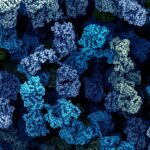Lien vers Pubmed [PMID] – 26483030
Yeast Functional Genomics: Methods and Protocols, 2015 Aug
The yeast systematic deletion collection offered the basis for a number of different strategies that establish functional links between genes by analyzing the phenotype of cells that combine two different deletions or mutations. A distinguishing feature of the collection is the presence of molecular barcodes at each deleted locus, which can be used to quantify the presence and abundance of cells bearing a given allele in a complex mix. As a result, a large number of mutants can be tested in batch cultures, replacing tedious manipulation of thousands of individual strains with a barcode microarray readout. Barcode-based genetic screens like Genetic Interaction Mapping (GIM) thus require little investment in terms of specific equipment, are fast to perform, and allow precise measurements of double mutant growth rates for both aggravating (synthetic sick) and alleviating (epistatic) effects. We describe here protocols for preparing the pools of haploid double mutant S. cerevisiae cells, testing their composition with barcode microarrays, and analyzing the results to extract useful functional information.


